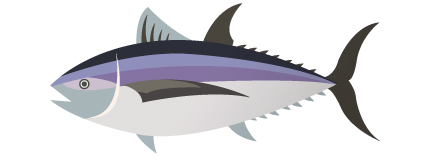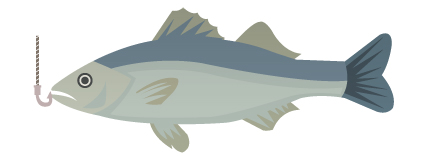Extinction risk
Cod 

40%
Reduction in the number of cod in Georges and Grand Banks in North America, where cod is traditionally abundant, over the past 10 years.
Pollock 
80%
Reduction in the number of the maximum sustainable yield in the Gulf of Maine in 2012. The situation is very severe.
Sources: The New York Times, Four Fish by Paul Greenberg
Chilean seabass 
(better known as snowfish)
5
Years in which environmentalists predict Chilean seabass will become extinct if people do not stop consuming.
Gurnard 
700
Number of chefs in the US that have vowed to stop including Chilean seabass on their menu since most are caught through pirate fishing.
Sources: National Geographic News
Bluefin tuna 
US$4 billion
Value of the bluefin tuna black market in Europe.
Albacore tuna 
80%
Percentage of tuna consumed in Japan that hails from pirate fishing.
Source: The New York Times
Unsustainable farming
Tiger prawns 

20
Hours per day illegal Burmese and Cambodian laborers are forced to work in many Thai shrimp farms.
Organic tiger prawn, langoustines, crab 
73
Percentage of Thai shrimp producers who report that they use antibiotics in their farming.
Sources: Daily Mail, Greenpeace
Seabass 
Wild-caught seabass 
17
Times by which environmentalists claim farmed seabass is fattier than wild-caught ones, due to antibiotics and pollution.
Source: The Guardian
Salmon 

1
Number of PCB-contaminated farmed salmon meals per month recommended by the US EPA (Environmental Protection Agency), compared to eight meals of wild-caught salmon.
Wild-caught Alaskan salmon 
74%
Percentage of embryos that die when escaped farmed salmon breed with wild salmon.
Sources: Greenpeace, Institute of Health and the Environment, University at Albany
Others on the Greenpeace Red List
Atlantic salmon

Reasons
1. Fishing method catches other vulnerable species
2. Unsustainable fishing
3. Overfishing
4. Unselective fishing methods
5. Pirate fishing
The Greenpeace Red List is the fish species that are near extinction, overfished or their fishery method is harmful to other species or the environment.
Where can you eat sustainable fish?
Oyster Bar. 395 Narathiwas Ratchanakarin Soi 24, 02-212-4809.
Open Mon-Sat 6-11pm; Sun 12-2:30pm, 5:30-10pm
Sustaina. 1/40 Sukhumvit Soi 39, 02-258-7573.
Open Mon-Sat 11am-9:30pm; Sun 11am-8:30pm
Snapper. 1/20-22 Sukhumvit Soi 11, 02-651-1098.
Open Mon-Fri 5pm-midnight; Sat-Sun 11am-midnight.
Essentials

Alternative option
 Avoid
Avoid









































































 Alternative option
Alternative option  Avoid
Avoid